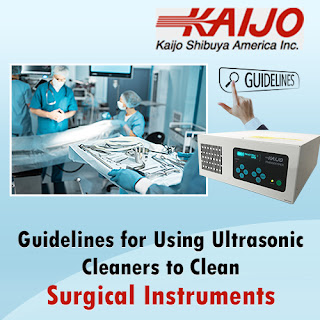Ultrasonic cleaners can deliver excellent cleaning and sterilizing to all types of surgical tools and instruments, which are normally difficult to clean using traditional cleaning methods.
Some instruments, such as laparoscopes used in minimally invasive surgery, may have heat-sensitive components, and can’t be sterilized in an autoclave. Some instruments have complex shapes with areas impossible to reach within manual cleaning. Using ultrasonic cleaners also reduces the risk to medical personnel of handling sharp tools.
Ultrasonic cleaners for medical instruments are deemed effective for cleaning, and as a result, a growing number of medical facilities have begun using them. Despite that, specific guidelines should be followed to ensure a safe and effective operation.
1) Although ultrasonic cleaners are highly effective in cleaning and sterilizing surgical tools, regular medical procedures should still be followed. For example, the tools should be rinsed right after use or kept moist to prevent blood, other bodily fluids, or other material from drying out, as dried contaminants are harder to clean out.
2) The manufacturer’s recommendations and the IFU should always be followed.
3) Effective cleaning depends on using the correct ultrasonic frequency. Cleaners used with only one type of instrument or application may have fixed frequency, while general-purpose cleaners can typically be operated at several frequencies, depending on what’s being cleaned.
4) Sterilization depends on using the right disinfectant and the right quantity. The IFU sometimes specify disinfectants to be used and the applicable research may be available for specific cases. Medical personnel should verify the type and concentration of the cleaning solution.
5) When operating properly, medical ultrasonic cleaners deliver stainless steel instruments that are shiny and completely clean while other parts will be visibly free of contaminants.
6) Besides the general instructions for the use of ultrasonic cleaners for surgical instruments, medical facilities should prepare specific use-based policies and procedures for cleaning different types of instruments with ultrasonic technology.
Kaijo works closely with all of the customers to ensure their ultrasonic cleaner requirements are met. You can learn more by reading the complete article, Guidelines for Using Ultrasonic Cleaners to Clean Surgical Instruments, and then by contacting Kaijo to ask questions or to set up a free consultation. You can reach Kaijo Shibuya by either calling 408-675-5575 or by emailing them at info@kaijo-shibuya.com.


